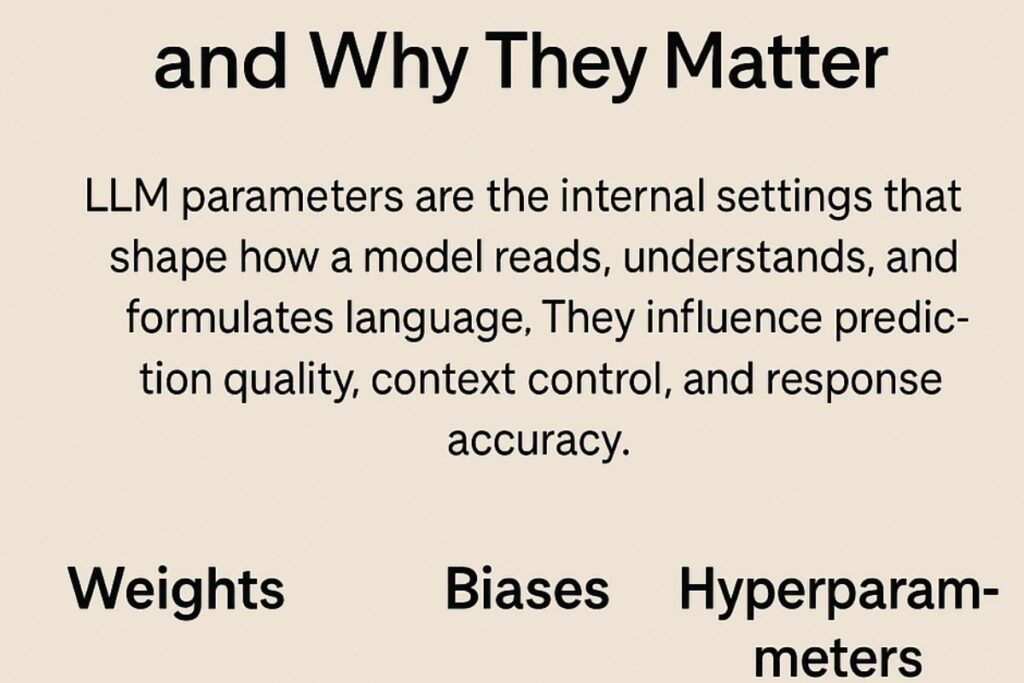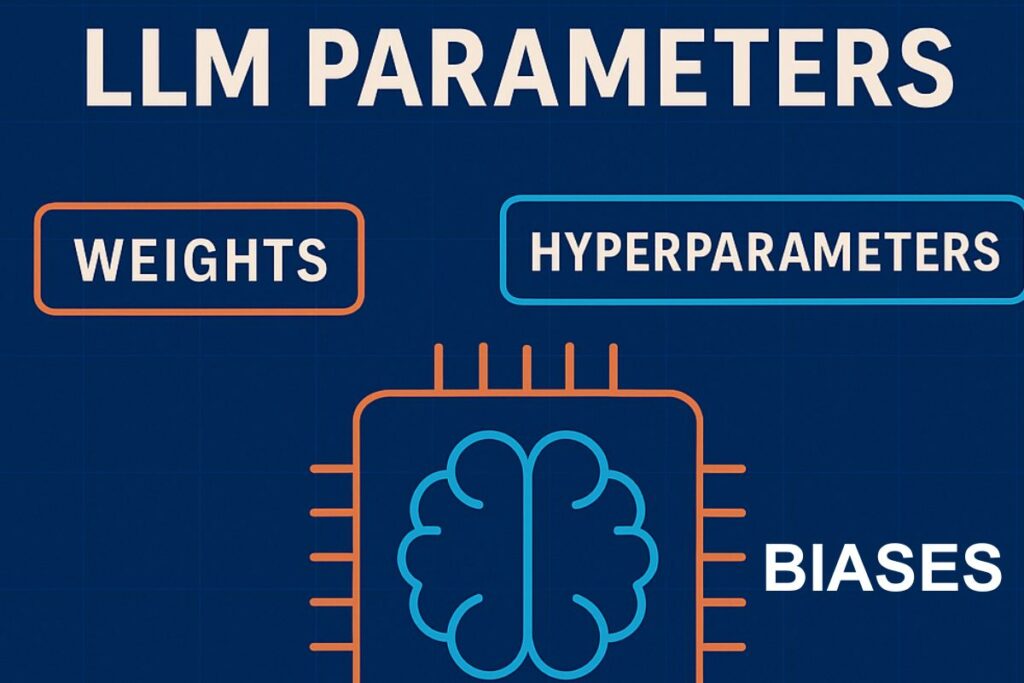LLM parameters form the foundation of how large language models behave interpret language and generate meaningful output. These parameters govern every decision a model makes from choosing words to recognizing patterns.
By understanding these internal elements it becomes possible to grasp why some models deliver coherent human like responses while others fall short. LLM parameters act as guides that determine strength creativity consistency and accuracy.
They hold the true key behind AI performance and language mastery.(What are LLM Parameters)LLM parameters consist of weights biases and hyperparameters. Each plays a distinct role in shaping how a model learns processes data and produces results.
These parameters do not store meaning instead they create pathways that allow a model to associate words and predict language flow. A powerful understanding of LLM parameters leads to better control stronger customization and deeper insight into artificial intelligence behavior.
This blog explores every core component of LLM parameters without complexity ensuring clarity for enthusiasts developers and professionals. No technical fluff only real understanding of how AI thinks and responds through its parameter system. For more insights on startup tech and digital growth, explore the Rteetech homepage.
What Are LLM Parameters? and Why They Matter

LLM parameters are the internal settings that shape how a model reads understands and formulates language. They influence prediction quality context control and response accuracy. Three primary types define LLM behavior
- Weights
- Biases
- Hyperparameters
Each group handles specific tasks combining to build a complete understanding of language generation and interpretation.Weights and biases are trained inside the model while hyperparameters are chosen before training to guide learning behavior and model control.
What Are LLM Parameters: Understanding the Role of Weights
Weights represent the importance given to different inputs during processing. They determine how strongly one word or concept influences another. If a certain word carries significance weights increase its impact leading to deeper relevance during response generation.
Weights adjust during training using feedback from loss functions. This process known as backpropagation ensures improved accuracy over time. High quality weights mean better language interpretation reduced confusion and improved context retention.
Inside neural networks weights connect layers passing signals forward. Each adjustment refines understanding allowing the model to recognize grammar patterns and semantic relationships.
Core Role of Parameters in Language Modeling
Parameters are the core components that shape how a language model understands and generates text. Each parameter works like a small switch that adjusts the model’s ability to recognize patterns and context from training data.
They help the model in three key ways
- Understanding Context
Parameters guide the model to read and interpret the meaning of words and phrases. - Generating Accurate Responses
They ensure the output is relevant logical and aligned with the prompt. - Storing Learned Knowledge
Parameters hold the information learned during training which improves response quality.
Simply put parameters act as the brain of the model. The more refined and well trained the parameters are the better the model performs in tasks like answering questions summarizing text and reasoning.
How Biases Improve AI Responses
Biases act as stabilizers providing flexibility when weights alone cannot activate neurons. They enable models to produce outputs even when input strength is weak. Biases add constant values ensuring meaningful responses under varying conditions.
Just like weights biases are trained through optimization. They enhance adaptability so the model can handle unusual sentences phrases or unexpected input structures. Without biases models often struggle with unpredictable patterns.
Together weights and biases determine the expressive power of an LLM. Strong coordination between them leads to natural fluid responses and accurate interpretations.
What Are LLM Parameters: Exploring Hyperparameters

Hyperparameters differ from weights and biases. They are external settings chosen before training to define learning strategy structure and performance boundaries. Hyperparameters decide how creative strict long or short responses should be.
Hyperparameters are crucial because they directly affect output behavior resource demand and training efficiency. Key hyperparameters include
- Learning rate
- Number of layers
- Context window
- Temperature
- Top p
- Top k
- Token limit
- Frequency penalty
- Presence penalty
- Stop sequence
Each hyperparameter offers control over AI personality style and output consistency.
Learning Rate and Model Stability Explained
Learning rate manages how quickly weights change during training. High learning rate causes large jumps risking instability. Low learning rate delivers precise gradual learning but may slow progress.
Balanced learning rate ensures high accuracy without losing optimization efficiency. Many models begin with higher rates and gradually reduce them for refinement.
What Are LLM Parameters: Number of Layers and AI Depth
Number of layers defines model complexity. More layers increase reasoning capability and pattern recognition. However unnecessary depth may cause overfitting leading to confusion on simple tasks.
Balanced layer architecture is essential. Too few layers reduce comprehension. Too many layers consume resources and reduce practicality.
What Are LLM Parameters: Context Window and Memory Control
Context window specifies how many tokens a model can retain while generating text. Larger windows support deeper context allowing long conversation or detailed analysis.
However larger context increases computational load. Smaller windows work for short responses but may lose track of meaning. An optimal context window ensures clear consistent understanding throughout input and output.
What Are LLM Parameters: Temperature and Response Creativity
Temperature determines creativity. Higher temperature increases randomness enabling dynamic expressive output. Lower temperature focuses on accuracy and consistency reducing imagination. Use high temperature for storytelling expression brainstorming. Use low temperature for clarity precision documentation.
Top p and Top k Sampling Techniques
Top p restricts token selection to a probability threshold ensuring balanced creativity. Top k limits token choices to the k most likely options.
Both control unpredictability. Top p emphasizes probability diversity. Top k prioritizes highest ranking options. Together they define how controlled or imaginative a model becomes.
What Are LLM Parameters: Frequency Penalty and Repetition Control
Frequency penalty reduces repeated words forcing vocabulary variation. This prevents monotony and improves natural flow.
Repetition penalty works similarly but applies stronger suppression over repeated use. Presence penalty applies only once avoiding overuse without completely blocking terms. These settings shape originality and prevent output stagnation.
Stop Sequences and Output Control
Stop sequence defines where a model should end its output. It ensures responses remain concise and relevant without excessive continuation. Stop sequences help maintain clarity especially in structured answers or single sentence outputs.
Optimizing LLM Parameters for Performance
Optimizing parameters means balancing precision creativity memory and speed. Weights and biases optimize understanding. Hyperparameters refine behavior.
Best performance comes from combining all parameter types with thoughtful tuning. Each element influences final coherence trust and usability.
Impact of What Are LLM Parameters on Real AI Applications

LLM parameters power real applications such as chatbots code assistants content creation and data interpretation. Strong parameter design ensures ethical efficient and responsible AI behavior.
Proper tuning helps achieve reliable output across industries including law healthcare education and research.
Conclusion
LLM parameters form the backbone of AI capability. Weights drive understanding biases enable adaptability and hyperparameters define personality. Together they shape how AI interprets and produces language. Mastering these elements unlocks control precision and intelligence within large language models.
True AI power lies not in model size but in parameter precision. Understanding LLM parameters reveals the unseen mechanisms that create meaningful responses and authentic interaction. learn more about our SEO for business growth strategies instead of just “Rteetech LCC”.
FAQs
What are LLM parameters?
LLM parameters are internal settings such as weights biases and hyperparameters that control how language models generate and understand responses. They determine interpretation accuracy and behavior.
Why are weights important in LLMs?
Weights determine the significance of specific inputs influencing confidence and relevance. They refine understanding by adjusting signal strength during training.
How do biases support language models?
Biases add flexibility when weights alone cannot trigger neuron activation. They allow the model to respond even with weak input improving adaptability.
What is the purpose of hyperparameters?
Hyperparameters guide learning structure and style. They control creativity depth memory and output constraints before training begins.
How does temperature affect AI output?
Temperature controls randomness. High temperature increases creativity. Low temperature maintains accuracy and structured responses.
What is context window in LLMs?
Context window defines how many tokens an LLM can consider at once. Larger windows enable long reasoning while smaller windows focus on short clear responses.
How do penalties improve response quality?
Frequency and repetition penalties prevent excessive word reuse promoting richer vocabulary and avoiding dull repetitive text.
Can LLM parameters improve real applications?
Yes strong parameter tuning improves reliability across chatbots analysis content tools and specialized AI tasks enhancing performance and trust.



